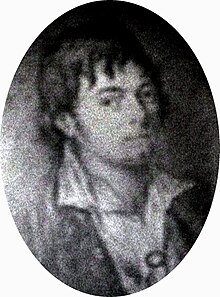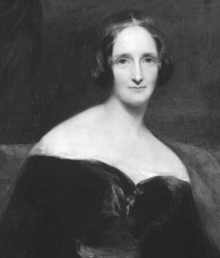Harriet de Boinville
The Second Carib War had just concluded on the island, and tensions remained high between the British colonists, French settlers, enslaved Africans, and the native Caribbeans who inhabited it.
Jean Baptiste de Boinville determined, "despite the entreaties of his wife, to seek some means of gaining his own bread and of living independently.
To win her release, Jean Baptiste took a coach from Dunkirk to Paris where he obtained official papers stating that she had permission to enter France.
[5] Her husband’s former commanding officer, “ever afterwards entertained toward her feelings of the highest and most friendly respect.”[6] Kenneth Neill Cameron states that she and Jean Baptiste were formally presented "to the now aging veteran of two revolutions.”[7] During the French Revolutionary and Napoleonic Wars, Harriet de Boinville repeatedly risked her life to cross the channel.
On one occasion she was nearly shipwrecked with her young children; on another she was taken prisoner at the Hague, “but the jailer was so fascinated by her beauty, and moved by her sorrows, that he contrived to allow her to make her escape.” To be with her husband she even sailed to France one time on a vessel commanded by smugglers; “rough weather came on, the vessel was driven ashore, and she had to get upon a sailor’s back to land; just then, a huge wave threw them all down, and she had the sorrow of seeing most of her bank-notes floating upon the foaming sea, without any hope of rescuing them.
Her grandson in his memoir discussed the “marital vicissitudes" of her nineteen-year wartime marriage characterized by danger and unwanted separations since she was British and her husband was from France, Britain’s enemy.
Posthumous biographies of Percy Bysshe Shelley describe Harriet de Boinville, the popular host of a salon at Bracknell.
“The simple fare of the poorest old woman, or the starved labourer, and his children, through a stern iron necessity, was the diet, through free will and deliberate choice of the most refined, elegant, accomplished, intellectual specimens of humanity.”[14] Harriet de Boinville was a vegetarian as was her brother-in-law, John Frank Newton, who also frequented the salons at Bracknell.
Shelley adopted a diet of fruits and vegetables and mentioned the Newtons' vegetable-fed children in Queen Mab, A Philosophical Poem: With Notes, published in the spring of 1813.
Twenty-year-old Percy Bysshe Shelley met the woman he called Mrs. Boinville in the spring of 1813, the same year that he completed his first major work, Queen Mab.
After a laudanum overdose and a breakdown, precipitated by marital problems, Shelley sought refuge at Bracknell, where he lived in February and March 1814.
On March 16, 1814, he wrote Thomas Jefferson Hogg, "I have been staying with Mrs. B for the last month; I have escaped, in the society of all that philosophy and friendship combine, from the dismaying solitude of myself.
They have revived in my heart the expiring flame of life.”[15] In a letter to Hogg on October 4, 1814, Shelley called his two months living at Bracknell "probably the happiest of my life: the calmest, the serenest, the most free from care....the presence of Mrs. Boinville and her daughter afforded a strange contrast to my former friendless and deplorable condition.
Harriet interpreted Mrs. Boinville's silence with the result that cannot be forgotten.”[19] A popular posthumous biography of Percy Shelley by Edward Dowden infuriated Mark Twain.
Twain considered Dowden’s portrayal of the dead poet too forgiving and so he wrote an article entitled “In Defense of Harriet Shelley.
I wish however that when you see her you would tell her that I have not forgotten her, or any of the amiable circle once assembled round her.”[24] Three months later he referred to Harriet de Boinville as his “lost friend” in a letter to Thomas Jefferson Hogg and praised her “freedom from certain prejudices” and “the elegance and delicate sensibility of her mind.”[25]
[29] In the summer of 1829, Harriet de Boinville received “a friendly letter” from Mary Shelley and the two widows began to correspond and see each other again.
[30] In these letters (dated October 16, 1829, June 11, 1836, December 18, 1837, and January 26, 1839), Harriet discussed her personal feelings about Shelley and Godwin and suggested ways in which she could help Mary promote their literary legacies.
By this time Mary had written the Gothic classic Frankenstein (1818); other novels (Valperga, The Last Man, Perkin Warbeck, Lodore, Falkner, and Mathilde), as well as History of a Six Weeks’ Tour.
Harriet discussed at length their mutual friend, the social reformer and abolitionist Frances Wright, and "the present affecting state of Italy” in the 1836 letter.
[32] In the early 1840s, Claire moved to Paris where she attended Harriet de Boinville's social gatherings, crowded with republicans and Italian revolutionaries.
In one letter to her half sister, Mary, she wrote:At Madame de Boinville's the people are clever and I go there and I like the conversation, but I am never allowed to speak myself...after fifteen years being silent, I want to talk a good deal...to clear out my mind of all the ideas that have been accumulating and literally rotting there for so many years - but they won't allow me this in Rue Clichy- the instant I speak, the whole coterie fall upon my words and pick them to pieces...seize upon my argument (so dear to me)...they are liberals of such opposite characters.
These letters, preserved in the New York Public Library, Henry W. and Albert A. Berg Collection of English and American Literature, reveal the interconnectedness of the d’Arblay and de Boinville families.
Harriet’s purpose in writing in 1802 was to commiserate with her friend’s fears about Alexandre’s safety; he was intending to return to military service for France as the leader of a brigade to Santo Domingo.
She begins the letter to Frances Burney d’Arblay, “Not many of those who are happy enough to be personally & intimately acquainted with you Madam, can have taken a deeper interest, or greater share in all the painful feelings that have lately agitated you.” In the 1814 letter Harriet apologizes for not replying promptly to a “delightful letter.” She thanks Frances Burney d’Arblay for her help: “how soothingly kind you were to me in my Illness in Paris.
Harriet discusses problems with the wartime post and writes, “I shall have the greatest pleasure in forwarding any letters for you my dear Madam.” The Peace of Amiens was short-lived (April 20, 1792 – March 25, 1802).
Godwin asked his friend James Marshall, also a young writer, to sail to the West Indies to convince Collins to fund their writing.
Harriet de Boinville died in Paris on March 1, 1847, at the age of seventy-three or seventy-four (exact day of birth unknown).
Writing in French, her friend Giovanni Ruffini informed her grandson Charles: “I am fulfilling a sad duty for your aunt Cornelia, broken by sorrow and fatigue.



